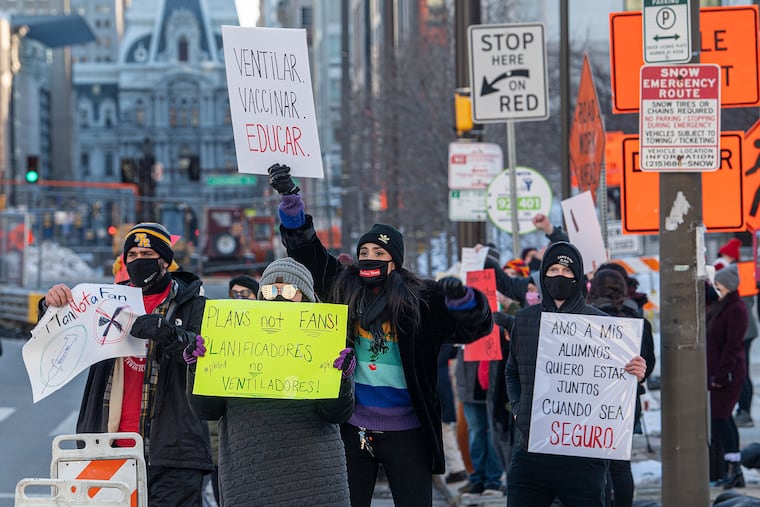How do we get kids back in schools? Stop teacher union bullying. | Opinion
Families and policymakers alike should tire of teacher unions’ attempts to maintain power when they are not delivering for our students.

The Philadelphia School District struggled to keep students engaged in school before the pandemic. Nothing during the COVID-19 era indicates the problem has gotten any better. Things may even be worse, as the district and its teachers’ union keepers have agreed with city officials not to resume in-person instruction in a city where 37% — more than one in three — students were found to be chronically absent before COVID-19 set in.
Who knows how many students are chronically absent now? On the second day of the 2020-21 school year, Philadelphia Superintendent William R. Hite Jr. said: “We will not be counting students absent if there are extenuating circumstances, and it is an extenuating circumstance if in fact you could not log on because of the server or you did not have the technology.”
As I explained for the Goldwater Institute recently, if 2021 is to be different from 2020 for your child in school, then policymakers, parents, and educators must have a conversation about bullying from education special-interest groups. Students and their education in the classroom should be made the priority. Families and policymakers alike should tire of teachers’ unions’ attempts to maintain power when they are not delivering for our students.
As students disappeared into the Wi-Fi, here’s how Philadelphia families and district officials arrived at a standoff with the teachers’ union: The American Federation for Teachers (AFT) announced last summer that “strikes could be used as a last resort” if unions did not find reopening plans to be safe enough. They needn’t have bothered. Like many other large school districts, Philadelphia school officials released a plan that said widespread face-to-face learning was “not a feasible model to start the school year.”
» READ MORE: Philly teachers don’t report to school buildings for a second day; teacher vaccinations expected to start Feb. 22
With plans to reopen in person on hold, Working Educators Philadelphia, a caucus of Philadelphia Federation of Teacher members, joined with the Democratic Socialists of America and others to focus on political causes, some unrelated to K-12 schools. The group demands “canceling rents and mortgages, a moratorium on evictions/foreclosures, providing direct cash assistance,” and “other critical social issues.”
Meanwhile, private and Catholic schools in Philadelphia and beyond opened with in-person and hybrid plans for 2020-21. According to a recent report from Catholic Philly, around the country, more than “90% of Catholic schools have been open for in-person learning and working within sanctioned health guidelines.”
On Feb. 5, Philadelphia district officials finally said pre-K through second grade teachers should report in-person on Feb. 8 with students to return Feb. 22.
» READ MORE: ‘We are not ready to go into unsafe buildings’: No word from mediator, but Philly teachers will still protest
Cue the strike. The same day as the district announcement, PFT’s Jerry Jordan said teachers should stay home.
Labor advocates are careful with the term strike, couching their language to make it sound as if walkouts are just advisory. Let’s use it for shorthand to save column inches — and because the same sequence of events between school districts and unions has played out elsewhere in cities such as Chicago.
Policymakers approved new spending to protect public classrooms, like the $4 million spent by Philadelphia schools to improve school ventilation systems; private and charter schools operated in-person with minimal infection rates; the Centers for Disease Control and Prevention and other health organizations released statements saying it is safe to reopen schools; and unions dug in, telling teachers to stay home.
So far, city and district officials have blinked to end the standoffs. Chicago officials just agreed to teachers’ unions’ terms for reopening after weeks of striking union members. There is still no plan to have high school students back in classrooms. Most students will not return for another month, so it’s early yet to consider the matter settled.
The same story is unfolding in Philadelphia. As of last Monday, Mayor Jim Kenney said teachers do not have to go back in person. Jordan announced a third-party mediator is now involved.
» READ MORE: In public protest, thousands of Philly teachers pushed back against reopening schools
Educators and policymakers should note that today’s drop in enrollment among kindergartners — down 10.5% in the region — signals increases in charter, homeschool, and private-school students tomorrow. A nationally representative survey finds that the share of parents who are “very satisfied” with private schools during the pandemic (55%) is more than double the rate for public schools. Charter-school parent satisfaction is 10 percentage points higher than traditional schools.
Remember the union’s position now when it decries lean school budgets in the fall.
Jonathan Butcher is the Will Skillman Fellow in Education at the Heritage Foundation.